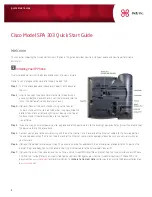
Introduction to RF troubleshooting
All measurements should be done using:
• spectrum analyser with a high-frequency high-impedance passive probe (LO-/reference frequencies and
RF power levels)
• oscilloscope with a 10:1 probe (DC-voltages and low frequency signals)
Caution:
All measurements with an RF coupler should be performed in RF shielded environment
because nearby base stations can disturb sensitive receiver measurements. If there is no possibility
to use RF shielded environment, it should be checked that there are no transmissions on the same
frequencies as used in the tests.
The RF section of the phone is build around two RF ASICS: Rx ASIC and Tx ASIC. There is also one GSM PA (Power
Amplifier) on board.
Most RF semiconductors are static discharge sensitive. ESD protection must be taken care of during repair
(ground straps and ESD soldering irons). The RF ASICs, PA and SMPS are moisture sensitive, so parts must be
pre-baked prior to soldering.
In addition to key components, there are lot of discrete components (resistors, inductors and capacitors)
which troubleshooting is done mainly by checking if the soldering of the component is done properly.
A capacitor can be checked for shorts and resistors for value by means of an ohmmeter, but be aware, in-
circuit measurements should be evaluated carefully.
Keep in mind that all measured voltages or RF levels in the service manual are rough figures. Especially RF
levels vary because of different measuring equipment or different grounding of the probe used. All spectrum
analyser measurements in this manual are made with a Fluke PM9639/011 10:1 (500 ohm) probe. It is
recommended that a similar kind of probe is used for all troubleshooting measurements.
When using an RF probe, use a pair of metallic tweezers to connect the probe ground to the PWB ground as
close to the measurement point as possible. If measurements are performed in a product specific module
jig, then “GND” pads should be used for the probe ground.
For additional RF troubleshooting instructions, see Appendix A. These instructions include descriptions/
instructions for RF self-tests as well as troubleshooting instructions for various fault cases.
RF key component placement
The RF section of the phone is build around two RF ASICs: Rx ASIC N7500 and Tx ASIC N7501.
There is one PA (Power Amplifier) on the board for GSM (N7502).
RM-180
RF Troubleshooting and Tuning Guide
Nokia Customer Care
Issue 1
COMPANY CONFIDENTIAL
Page 7 –5
Copyright © 2006 Nokia. All rights reserved.
















































